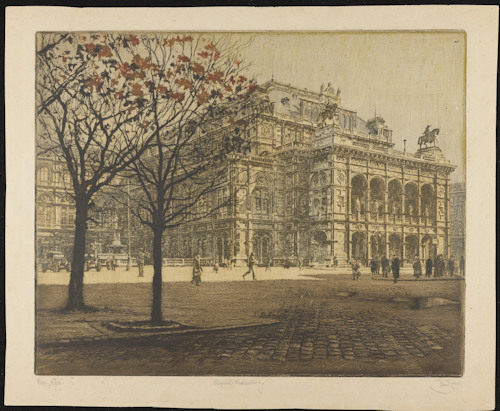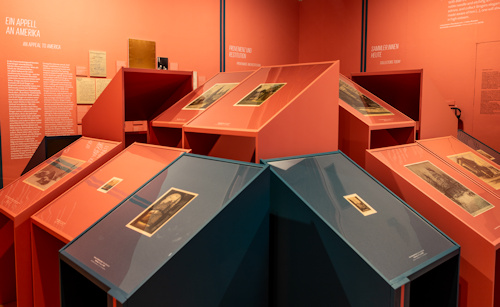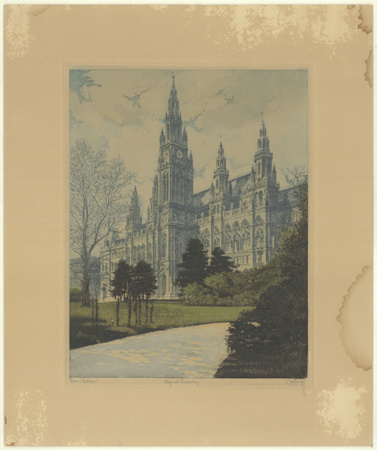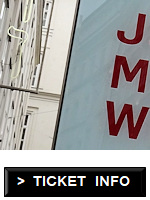Murdered by the Nazis, Emil Singer and his creative legacy might easily have fallen into oblivion. Collectors, donors and the Jewish Museum have brought the artist and his etchings back to life through the Viennese Nostalgia exhibition.
- Biographical elements explain the Singer story
- Tragedy tinged with optimism and beauty
- View etchings of Vienna in the early 1900s
- Runs Feb 14 – Sept 1, 2024
- All text in English & German
- Book Jewish Museum tickets* online
- See also:
A story in art

(Emil Singer: Vienna, Oper. Etching c. 1930; press photo © JMW / Donation by Dr. Sandy Rikoon)
Although occupying just one room, Viennese Nostalgia – Connected Memories of Emil Singer packs a lot of emotion into a small space.
Coloured etchings by Singer (1881-1942) lie at the exhibition’s centre (literally and figuratively), with a display of around 17 gorgeous prints of Viennese landmarks and scenes from the early 20th century.
The images include sights familiar today, like the Karlskirche church or the Parliament building, and project a certain deceptive comfort…perhaps a wistfulness with a slice of longing. As if they show a better place that might have once existed.
Some of the popularity of those etchings at the time can be explained by that evoking of nostalgia, especially in the difficult post-WWI era.
Singer’s only known self-portrait (from 1915) hangs on a wall and also seems to also have a wistful depth to it.

(View of the exhibition; press photo © Tobias von Marillac)
Your response to the artistry and images changes, though, when you discover what brief details we know of Singer’s story: presented around the sides of the room with the help of photos and documents.
We learn that Singer was able to earn a living as an artist. At least until the fascist authorities banned him from selling domestically due to his Jewish heritage. Thereafter he relied on contacts and supporters in the US to sell his work abroad.
As Nazi oppression tightened, Singer and his wife then sought to flee Austria, but the US authorities turned down their visa application.
Some faceless consulate employee took a decision that would result in a tragically familiar tale: the couple were later deported and murdered by the Nazis. Singer’s supporters in the US only found out long after the event.

(Emil Singer: Vienna, Rathaus. Etching, c. 1930; press photo © JMW / Donation by Henry Isaacs)
The impact of the small exhibition is multifold.
We have art to enjoy but also see how an understanding of its provenance changes your experience of the works.
We have reminders of the bureaucratic banality that enables and reflects evil. For example: a copy of an innocent-looking 1938 auction list that features one of Singer’s etchings. The seller? The Gestapo. The items? Stolen by the state.
We have the tragedy of lives lost to that evil.
And yet we also have optimism. In the efforts by those who were ostensibly strangers to Singer to get him away safely to the US. Those who could easily have looked away, but chose not to.
And we have a life rediscovered, even honoured, through the efforts of collectors, researchers, donors and the curatorial team. A Terry Pratchett quote (from his book Going Postal) always comes to mind on such occasions:
Do you not know that a man is not dead while his name is still spoken?
Dates, tickets & tips
Indulge in some Viennese nostalgia from February 14th to September 1st, 2024. An entrance ticket for or from the Jewish Museum includes the special exhibition.
(Booking service provided by Tiqets.com*, who I am an affiliate of)
The adjoining Who cares? exhibition on Jewish responses to suffering in Vienna also has one of Emil Singer’s etchings of Karlskirche on display.
For another “nostalgic” journey through the city, consider the Wien Museum. Their permanent exhibition takes you across Vienna’s sociocultural and formal history with a layer of art to illustrate eras. Browse their online collection for photos, prints and paintings of Viennese cityscapes through time.
For more etchings, try the Albertina Museum: they often have special exhibitions built around the medium given their astonishing in-house collection of printed works.
How to get there
Follow the travel tips on the museum overview article. You want the main Dorotheergasse location. The Singer exhibition is one floor above the entrance level and immediately to your right as you come up the stairs or emerge from the lift.
Address: Dorotheergasse 11, 1010 Vienna
